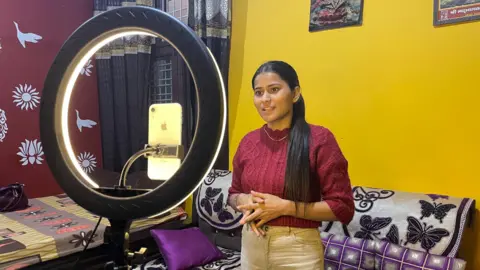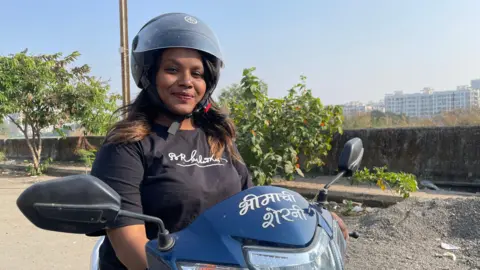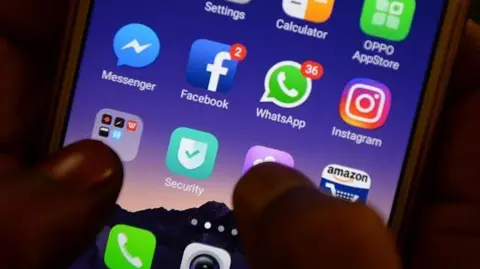Divya Arya,BBC Hindi

BBC
Shivi Dikshit shoots Instagram Reels at home for her 150,000 followers
Young women in small towns and villages across India are proudly trumpeting their caste identities on Instagram, making it the latest battleground for caste politics.
The BBC tracked 100 accounts and spoke to a dozen such influencers across the caste divide to understand what's driving the trend.
The camera focuses on a woman in a black dress. She is pointing a rifle at the sky with her hand on the trigger.
"Who are you?" asks an accompanying voiceover. "We are Brahmins," a voice responds. The woman smiles, and the sound of two gunshots is heard.
This is just one of hundreds of Instagram Reels made by Shivi Dikshit, a 24-year-old from the northern state of Uttar Pradesh who shares short videos about her Brahmin caste with her 150,000 followers on Instagram.
Hinduism's deeply hierarchical caste system, which dates back at least 3,000 years, puts Brahmins or priests at the top and Dalits (formerly untouchables) at the bottom.
Caste-based discrimination has been illegal in India for decades, but the country's 200 million Dalits continue to find themselves among the most marginalised citizens. Despite reforms, caste also remains a strong marker of identity in everyday conversations in many parts of the country.Caste hatred in India - what it looks like
How the British reshaped India's caste system
In the videos, which are shot at home and have more than a million views, Ms Dikshit talks about the "superiority" of Brahmins as she pours scorn on the notion of inter-caste relations and rejects affirmative policies aimed at empowering Dalits.
"Brahmins have a cultural upbringing [unlike other caste groups]. Everyone in my family is a practising priest. I want to propagate the values we practice and dispel myths about my community," she tells me while sitting on the terrace of her family-owned temple in the northern town of Meerut.
Ms Dikshit is among the thousands of Indian women who are using Instagram to talk about their caste in new and imaginative ways.
Most of them are from small towns and villages - unusual in a country where, unlike men, very few women speak publicly about their religious and caste identities. But access to social media, they say, has given them a platform to freely express themselves and challenge patriarchal controls.

Simi Jadhav, a 22-year-old Dalit woman, says she finds Instagram empowering
A study done by the Centre for the Study of Developing Societies (CSDS) between 2014 and 2019 notes there has been a "democratisation of the social media space" in India, especially among the "less educated and those living in rural areas".
And it's not just women from privileged castes - the strident views of those like Ms Dikshit have met a fightback from the Dalit community.
Seemi Milind Jadhav, a 22-year-old beautician, goes by the name Bhimachi Sherni on Instagram. It's a reference to Bhimrao Ramji Ambedkar, a Dalit icon and the architect of India's constitution, while Sherni means lioness in Urdu.
"I look upon Ambedkar as a father figure. So, I am my father's lioness," she says.
Ms Jadhav, who lives on the outskirts of India's financial capital Mumbai, says she began making Reels after coming across "myths and disinformation being spread by upper-caste handles on Instagram".In pictures: The many lives of India's Dalits
What is India's caste system?
"I started educating myself about Ambedkar's teachings and caste politics, slowly I found a whole community of like-minded Dalits online," she told me.
"We now brainstorm and come up with our own Reels in response."
Most of the women the BBC spoke to said they made their online debut on the Chinese app TikTok and moved to Instagram after India banned it in 2020.
The content they share is wide-ranging, but recurring themes include descriptions of "the ideal" Brahmin or Dalit man and a strong rejection of inter-caste marriages.
These opinions can seem contrarian to a modern image of India - but data shows it's not uncommon. A Pew Research Center survey in 2019-2020 had more than 60% of respondents say it was important to stop both men and women in their community from marrying into other castes.

Many young Indian women are using Instagram to talk about their caste identities
These influencers also highlight the fault lines in a country marked by religious and social divisions.
Brahmin women speak of uniting Brahmins and the Hindu community to contribute "to the building of the Hindu nation".
But Dalit women like Ms Jadhav oppose the idea. They say if that happens, the strides the community has made in accessing education, employment and a life of dignity will be halted, pushing Dalits back to the margins.
Hilal Ahmed, an assistant professor at CSDS, says the trend shows how women are rejecting popular assumptions that they are not interested in politics.
"Women are seen as bearers of culture and tradition that are derived from caste and religion," he explains.
"It is not surprising that now that they have a medium to express themselves, they want to own those identities and share their opinion about them."
But he adds that in the name of pride, these women are often perpetuating existing social divides.
"It's a paradox. They assert a sense of victimhood that their communities are under threat while also claiming that they don't fear anyone."
Some of the content shared is also provocative, with Reels bordering on hate speech and violence. The BBC contacted Meta about a few such videos, following which the company took them down from the platform.
A Meta spokesperson said the company's community standards prohibit content targeting a person or group of people on the basis of their caste which is "a protected characteristic".
"Any content that threatens or incites violence is also prohibited," the spokesperson added.

Women say Instagram has given them a space to speak their mind
The women, however, dismiss allegations of casteism and violence and claim they are only trying to unite their community.
Samiksha Sharma, who describes herself as Brahmin on Instagram, says she is often accused of "dividing people" and receives hostile comments
"However, I don't see it that way," the 24-year-old adds.
"I take inspiration from other Brahmin handles and promote our community."
In a country where millions of young adult women cannot even own a mobile phone without their parents' permission, Ms Jadhav says the platform allows her to navigate patriarchy through technology.
When she first began making Reels in 2019, she did not tell her parents, recording them secretly at a salon where she worked to support her family.
But she says the solidarities she built with women online gave her the courage to tell them the truth and assert her identity.
"They were shocked but proud that I was doing this for the community. So now I don't need to hide."
Shivi Dikshit shoots Instagram Reels at home for her 150,000 followers
Young women in small towns and villages across India are proudly trumpeting their caste identities on Instagram, making it the latest battleground for caste politics.
The BBC tracked 100 accounts and spoke to a dozen such influencers across the caste divide to understand what's driving the trend.
The camera focuses on a woman in a black dress. She is pointing a rifle at the sky with her hand on the trigger.
"Who are you?" asks an accompanying voiceover. "We are Brahmins," a voice responds. The woman smiles, and the sound of two gunshots is heard.
This is just one of hundreds of Instagram Reels made by Shivi Dikshit, a 24-year-old from the northern state of Uttar Pradesh who shares short videos about her Brahmin caste with her 150,000 followers on Instagram.
Hinduism's deeply hierarchical caste system, which dates back at least 3,000 years, puts Brahmins or priests at the top and Dalits (formerly untouchables) at the bottom.
Caste-based discrimination has been illegal in India for decades, but the country's 200 million Dalits continue to find themselves among the most marginalised citizens. Despite reforms, caste also remains a strong marker of identity in everyday conversations in many parts of the country.Caste hatred in India - what it looks like
How the British reshaped India's caste system
In the videos, which are shot at home and have more than a million views, Ms Dikshit talks about the "superiority" of Brahmins as she pours scorn on the notion of inter-caste relations and rejects affirmative policies aimed at empowering Dalits.
"Brahmins have a cultural upbringing [unlike other caste groups]. Everyone in my family is a practising priest. I want to propagate the values we practice and dispel myths about my community," she tells me while sitting on the terrace of her family-owned temple in the northern town of Meerut.
Ms Dikshit is among the thousands of Indian women who are using Instagram to talk about their caste in new and imaginative ways.
Most of them are from small towns and villages - unusual in a country where, unlike men, very few women speak publicly about their religious and caste identities. But access to social media, they say, has given them a platform to freely express themselves and challenge patriarchal controls.

Simi Jadhav, a 22-year-old Dalit woman, says she finds Instagram empowering
A study done by the Centre for the Study of Developing Societies (CSDS) between 2014 and 2019 notes there has been a "democratisation of the social media space" in India, especially among the "less educated and those living in rural areas".
And it's not just women from privileged castes - the strident views of those like Ms Dikshit have met a fightback from the Dalit community.
Seemi Milind Jadhav, a 22-year-old beautician, goes by the name Bhimachi Sherni on Instagram. It's a reference to Bhimrao Ramji Ambedkar, a Dalit icon and the architect of India's constitution, while Sherni means lioness in Urdu.
"I look upon Ambedkar as a father figure. So, I am my father's lioness," she says.
Ms Jadhav, who lives on the outskirts of India's financial capital Mumbai, says she began making Reels after coming across "myths and disinformation being spread by upper-caste handles on Instagram".In pictures: The many lives of India's Dalits
What is India's caste system?
"I started educating myself about Ambedkar's teachings and caste politics, slowly I found a whole community of like-minded Dalits online," she told me.
"We now brainstorm and come up with our own Reels in response."
Most of the women the BBC spoke to said they made their online debut on the Chinese app TikTok and moved to Instagram after India banned it in 2020.
The content they share is wide-ranging, but recurring themes include descriptions of "the ideal" Brahmin or Dalit man and a strong rejection of inter-caste marriages.
These opinions can seem contrarian to a modern image of India - but data shows it's not uncommon. A Pew Research Center survey in 2019-2020 had more than 60% of respondents say it was important to stop both men and women in their community from marrying into other castes.

Many young Indian women are using Instagram to talk about their caste identities
These influencers also highlight the fault lines in a country marked by religious and social divisions.
Brahmin women speak of uniting Brahmins and the Hindu community to contribute "to the building of the Hindu nation".
But Dalit women like Ms Jadhav oppose the idea. They say if that happens, the strides the community has made in accessing education, employment and a life of dignity will be halted, pushing Dalits back to the margins.
Hilal Ahmed, an assistant professor at CSDS, says the trend shows how women are rejecting popular assumptions that they are not interested in politics.
"Women are seen as bearers of culture and tradition that are derived from caste and religion," he explains.
"It is not surprising that now that they have a medium to express themselves, they want to own those identities and share their opinion about them."
But he adds that in the name of pride, these women are often perpetuating existing social divides.
"It's a paradox. They assert a sense of victimhood that their communities are under threat while also claiming that they don't fear anyone."
Some of the content shared is also provocative, with Reels bordering on hate speech and violence. The BBC contacted Meta about a few such videos, following which the company took them down from the platform.
A Meta spokesperson said the company's community standards prohibit content targeting a person or group of people on the basis of their caste which is "a protected characteristic".
"Any content that threatens or incites violence is also prohibited," the spokesperson added.

Women say Instagram has given them a space to speak their mind
The women, however, dismiss allegations of casteism and violence and claim they are only trying to unite their community.
Samiksha Sharma, who describes herself as Brahmin on Instagram, says she is often accused of "dividing people" and receives hostile comments
"However, I don't see it that way," the 24-year-old adds.
"I take inspiration from other Brahmin handles and promote our community."
In a country where millions of young adult women cannot even own a mobile phone without their parents' permission, Ms Jadhav says the platform allows her to navigate patriarchy through technology.
When she first began making Reels in 2019, she did not tell her parents, recording them secretly at a salon where she worked to support her family.
But she says the solidarities she built with women online gave her the courage to tell them the truth and assert her identity.
"They were shocked but proud that I was doing this for the community. So now I don't need to hide."
No comments:
Post a Comment